Evaluating Audi Training Program Using ROI Model
VerifiedAdded on 2019/12/03
|17
|4002
|256
Essay
AI Summary
The assignment content discusses the importance of training and development in organizations. It highlights various models such as Kirkpatrick Model, CIRO model, and ROI method for evaluating the effectiveness of training programs. The report concludes that employability skills are essential for every organization, and it assesses the significance of training and development through a case study of Audi's training program. The content also touches upon the topic of reviewing plans, goal setting, and performance evaluation.
Contribute Materials
Your contribution can guide someone’s learning journey. Share your
documents today.
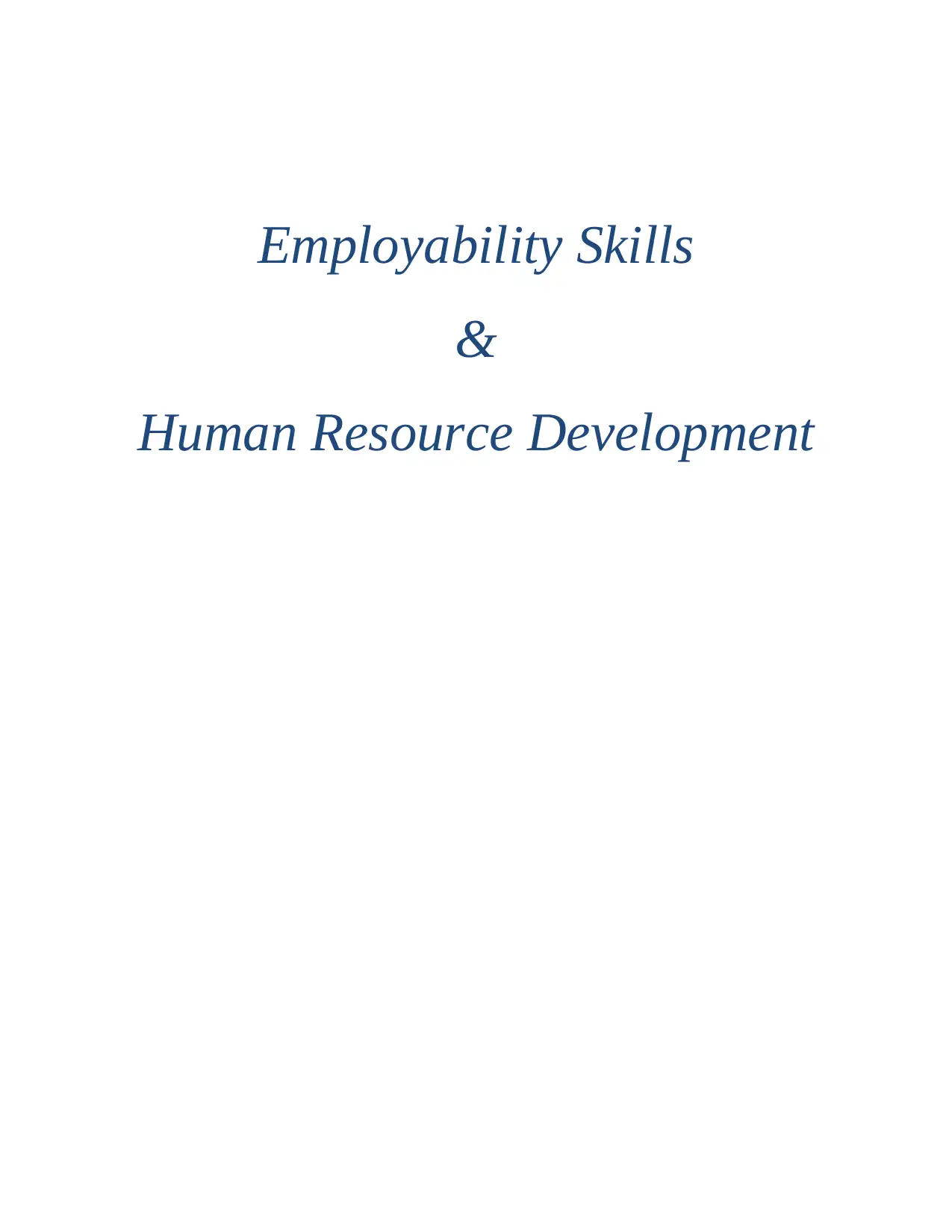
Employability Skills
&
Human Resource Development
&
Human Resource Development
Secure Best Marks with AI Grader
Need help grading? Try our AI Grader for instant feedback on your assignments.
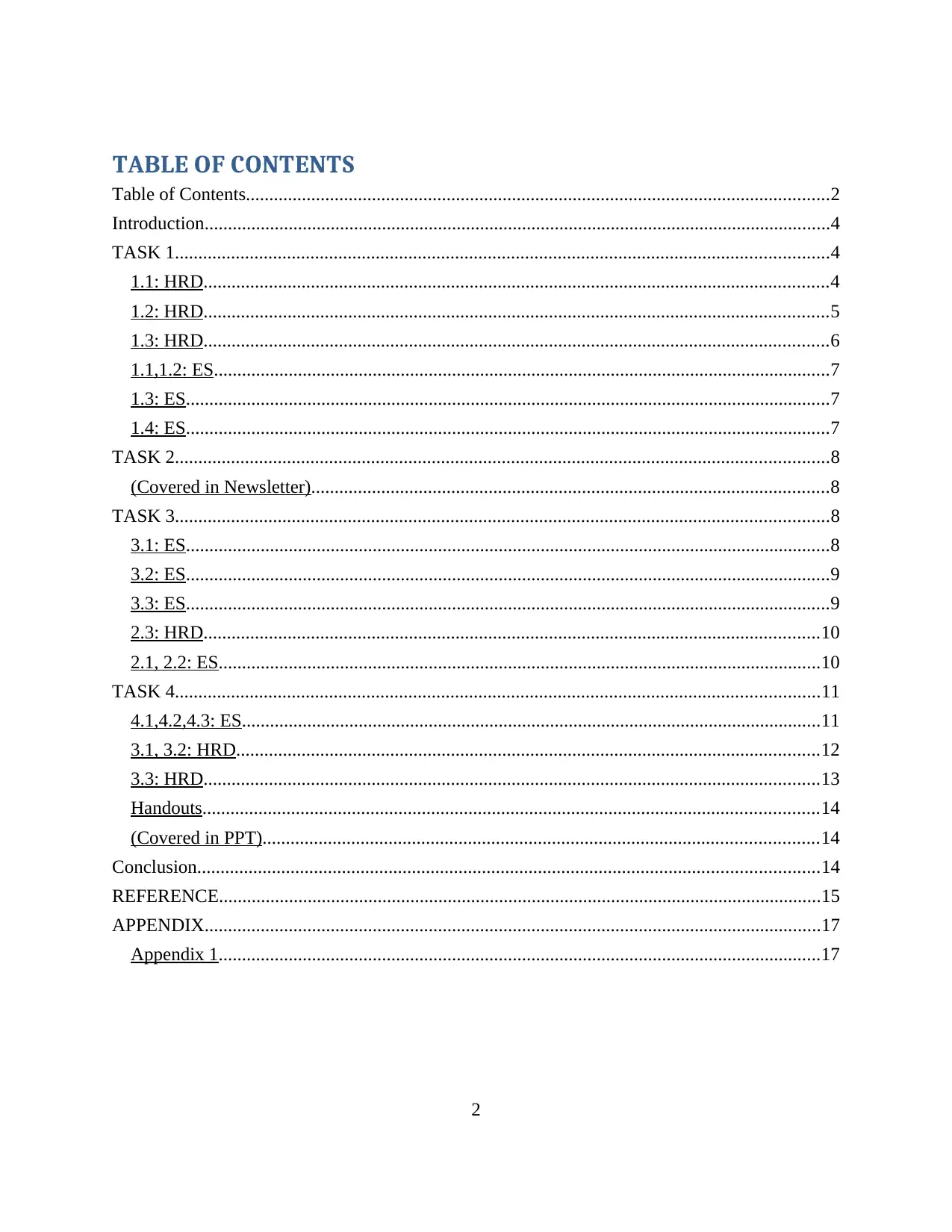
TABLE OF CONTENTS
Table of Contents.............................................................................................................................2
Introduction......................................................................................................................................4
TASK 1............................................................................................................................................4
1.1: HRD......................................................................................................................................4
1.2: HRD......................................................................................................................................5
1.3: HRD......................................................................................................................................6
1.1,1.2: ES....................................................................................................................................7
1.3: ES..........................................................................................................................................7
1.4: ES..........................................................................................................................................7
TASK 2............................................................................................................................................8
(Covered in Newsletter)...............................................................................................................8
TASK 3............................................................................................................................................8
3.1: ES..........................................................................................................................................8
3.2: ES..........................................................................................................................................9
3.3: ES..........................................................................................................................................9
2.3: HRD....................................................................................................................................10
2.1, 2.2: ES.................................................................................................................................10
TASK 4..........................................................................................................................................11
4.1,4.2,4.3: ES............................................................................................................................11
3.1, 3.2: HRD.............................................................................................................................12
3.3: HRD....................................................................................................................................13
Handouts....................................................................................................................................14
(Covered in PPT).......................................................................................................................14
Conclusion.....................................................................................................................................14
REFERENCE.................................................................................................................................15
APPENDIX....................................................................................................................................17
Appendix 1.................................................................................................................................17
2
Table of Contents.............................................................................................................................2
Introduction......................................................................................................................................4
TASK 1............................................................................................................................................4
1.1: HRD......................................................................................................................................4
1.2: HRD......................................................................................................................................5
1.3: HRD......................................................................................................................................6
1.1,1.2: ES....................................................................................................................................7
1.3: ES..........................................................................................................................................7
1.4: ES..........................................................................................................................................7
TASK 2............................................................................................................................................8
(Covered in Newsletter)...............................................................................................................8
TASK 3............................................................................................................................................8
3.1: ES..........................................................................................................................................8
3.2: ES..........................................................................................................................................9
3.3: ES..........................................................................................................................................9
2.3: HRD....................................................................................................................................10
2.1, 2.2: ES.................................................................................................................................10
TASK 4..........................................................................................................................................11
4.1,4.2,4.3: ES............................................................................................................................11
3.1, 3.2: HRD.............................................................................................................................12
3.3: HRD....................................................................................................................................13
Handouts....................................................................................................................................14
(Covered in PPT).......................................................................................................................14
Conclusion.....................................................................................................................................14
REFERENCE.................................................................................................................................15
APPENDIX....................................................................................................................................17
Appendix 1.................................................................................................................................17
2
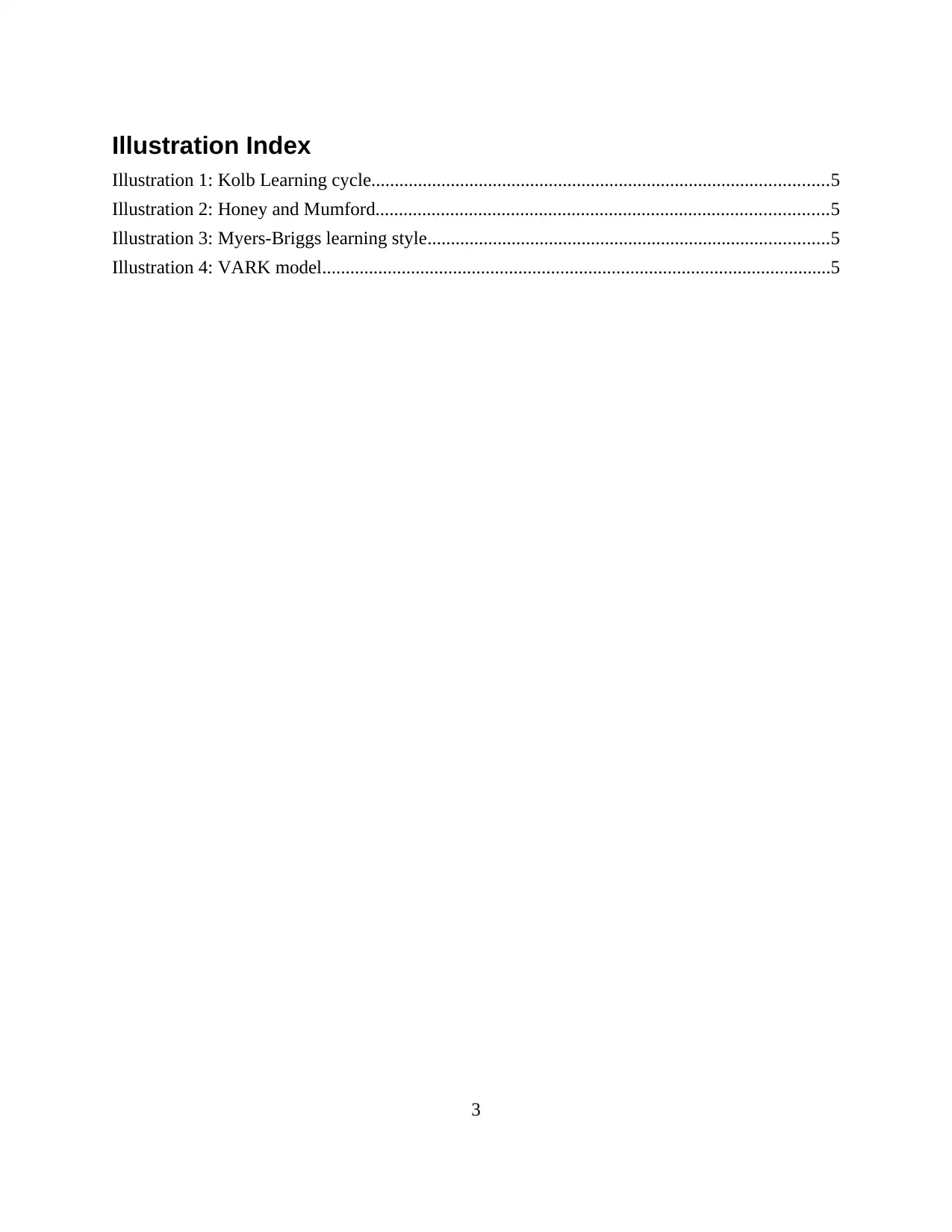
Illustration Index
Illustration 1: Kolb Learning cycle..................................................................................................5
Illustration 2: Honey and Mumford.................................................................................................5
Illustration 3: Myers-Briggs learning style......................................................................................5
Illustration 4: VARK model.............................................................................................................5
3
Illustration 1: Kolb Learning cycle..................................................................................................5
Illustration 2: Honey and Mumford.................................................................................................5
Illustration 3: Myers-Briggs learning style......................................................................................5
Illustration 4: VARK model.............................................................................................................5
3

INTRODUCTION
Manpower is the biggest strength of every organization. Human Resource Management
(HRM) of enterprise work to involve practices that create opportunities for improving their job
processes. Training and Development (T&D) is a planned way of developing Employability
Skills (ES) and abilities of the workforce. Audi is a subsidiary organization of Volkswagen
Group of German. It deals in manufacturing, designing, producing, marketing and distribution of
automobiles around the globe (Audi, 2015). With the need of working on employability skills of
the technician department of this company, line managers at HRD have identified personal
T&DE needs at Audi's training centers. With the use of Training Needs Analysis (TNA) tool,
Personal Development Plan (PDP) has been worked out in the present report. Along with this,
different aspects of ES and HRD such as different skills, working dynamics, learning theories,
training plans and government led initiatives have been discussed.
TASK 1
1.1: HRD
Comparing learning
styles in human resource development theory
Basis Kolb Learning style Honey and Mumford
learning style
Myers-Briggs learning
style
VARK learning style
Meaning The concept of maximizing
one's learning through
experience is reflected in
this style.
By expanding another model
in comparison to Kolb, the
concept lies in having strong
preference for one stage in
the cycle.
In comparison to other
styles, learning is made
through creation of new
learning environment.
The combination of
learning by using basic
styles or preferences.
Explana
tion
Concrete Experience:
Learning by specific
experiences.
Abstract
conceptualization:Learning
by thinking and analyzing
Actively
experimenting:Learning by
physical involvement
Activist: Learning through
new experiences and ideas
Reflectors:Data collected to
arrive at conclusions
Theorist: Adapt and
integrate complex situations
in learning.
Pragmatists: Learning is
Judging: Step by step
learning to meet current
and future use.
Perceiving: Learning is
made through active
participation.
Feeling: learns through
self imaginative way
Visual:Charts or graphs
are shown for grasping
things by seeing.
Auditory:Explanations are
listened for learning.
Read/Write: Practicing
reading and written
learning
4
Manpower is the biggest strength of every organization. Human Resource Management
(HRM) of enterprise work to involve practices that create opportunities for improving their job
processes. Training and Development (T&D) is a planned way of developing Employability
Skills (ES) and abilities of the workforce. Audi is a subsidiary organization of Volkswagen
Group of German. It deals in manufacturing, designing, producing, marketing and distribution of
automobiles around the globe (Audi, 2015). With the need of working on employability skills of
the technician department of this company, line managers at HRD have identified personal
T&DE needs at Audi's training centers. With the use of Training Needs Analysis (TNA) tool,
Personal Development Plan (PDP) has been worked out in the present report. Along with this,
different aspects of ES and HRD such as different skills, working dynamics, learning theories,
training plans and government led initiatives have been discussed.
TASK 1
1.1: HRD
Comparing learning
styles in human resource development theory
Basis Kolb Learning style Honey and Mumford
learning style
Myers-Briggs learning
style
VARK learning style
Meaning The concept of maximizing
one's learning through
experience is reflected in
this style.
By expanding another model
in comparison to Kolb, the
concept lies in having strong
preference for one stage in
the cycle.
In comparison to other
styles, learning is made
through creation of new
learning environment.
The combination of
learning by using basic
styles or preferences.
Explana
tion
Concrete Experience:
Learning by specific
experiences.
Abstract
conceptualization:Learning
by thinking and analyzing
Actively
experimenting:Learning by
physical involvement
Activist: Learning through
new experiences and ideas
Reflectors:Data collected to
arrive at conclusions
Theorist: Adapt and
integrate complex situations
in learning.
Pragmatists: Learning is
Judging: Step by step
learning to meet current
and future use.
Perceiving: Learning is
made through active
participation.
Feeling: learns through
self imaginative way
Visual:Charts or graphs
are shown for grasping
things by seeing.
Auditory:Explanations are
listened for learning.
Read/Write: Practicing
reading and written
learning
4
Paraphrase This Document
Need a fresh take? Get an instant paraphrase of this document with our AI Paraphraser
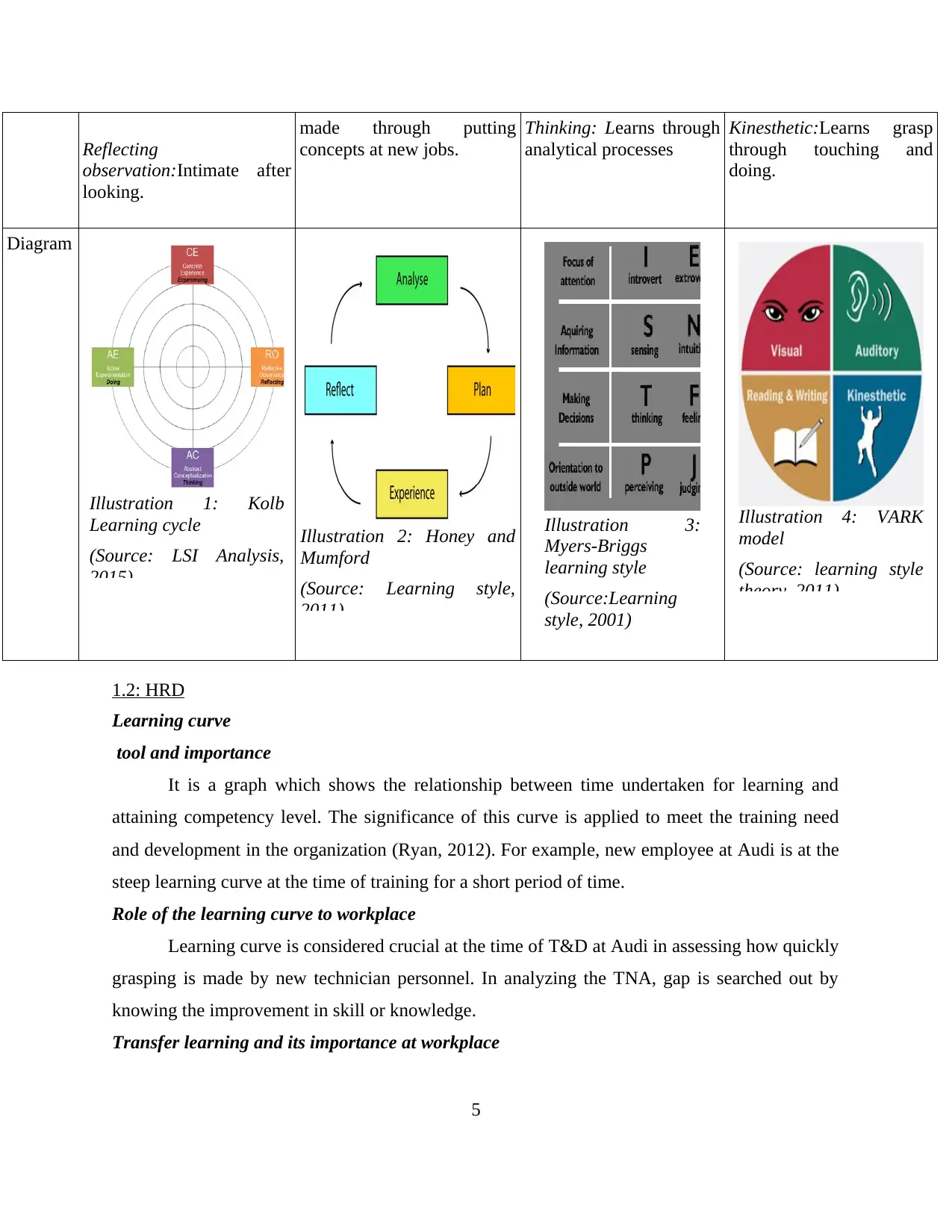
Reflecting
observation:Intimate after
looking.
made through putting
concepts at new jobs.
Thinking: Learns through
analytical processes
Kinesthetic:Learns grasp
through touching and
doing.
Diagram
1.2: HRD
Learning curve
tool and importance
It is a graph which shows the relationship between time undertaken for learning and
attaining competency level. The significance of this curve is applied to meet the training need
and development in the organization (Ryan, 2012). For example, new employee at Audi is at the
steep learning curve at the time of training for a short period of time.
Role of the learning curve to workplace
Learning curve is considered crucial at the time of T&D at Audi in assessing how quickly
grasping is made by new technician personnel. In analyzing the TNA, gap is searched out by
knowing the improvement in skill or knowledge.
Transfer learning and its importance at workplace
5
Illustration 1: Kolb
Learning cycle
(Source: LSI Analysis,
2015)
Illustration 2: Honey and
Mumford
(Source: Learning style,
2011)
Illustration 3:
Myers-Briggs
learning style
(Source:Learning
style, 2001)
Illustration 4: VARK
model
(Source: learning style
theory, 2011)
observation:Intimate after
looking.
made through putting
concepts at new jobs.
Thinking: Learns through
analytical processes
Kinesthetic:Learns grasp
through touching and
doing.
Diagram
1.2: HRD
Learning curve
tool and importance
It is a graph which shows the relationship between time undertaken for learning and
attaining competency level. The significance of this curve is applied to meet the training need
and development in the organization (Ryan, 2012). For example, new employee at Audi is at the
steep learning curve at the time of training for a short period of time.
Role of the learning curve to workplace
Learning curve is considered crucial at the time of T&D at Audi in assessing how quickly
grasping is made by new technician personnel. In analyzing the TNA, gap is searched out by
knowing the improvement in skill or knowledge.
Transfer learning and its importance at workplace
5
Illustration 1: Kolb
Learning cycle
(Source: LSI Analysis,
2015)
Illustration 2: Honey and
Mumford
(Source: Learning style,
2011)
Illustration 3:
Myers-Briggs
learning style
(Source:Learning
style, 2001)
Illustration 4: VARK
model
(Source: learning style
theory, 2011)
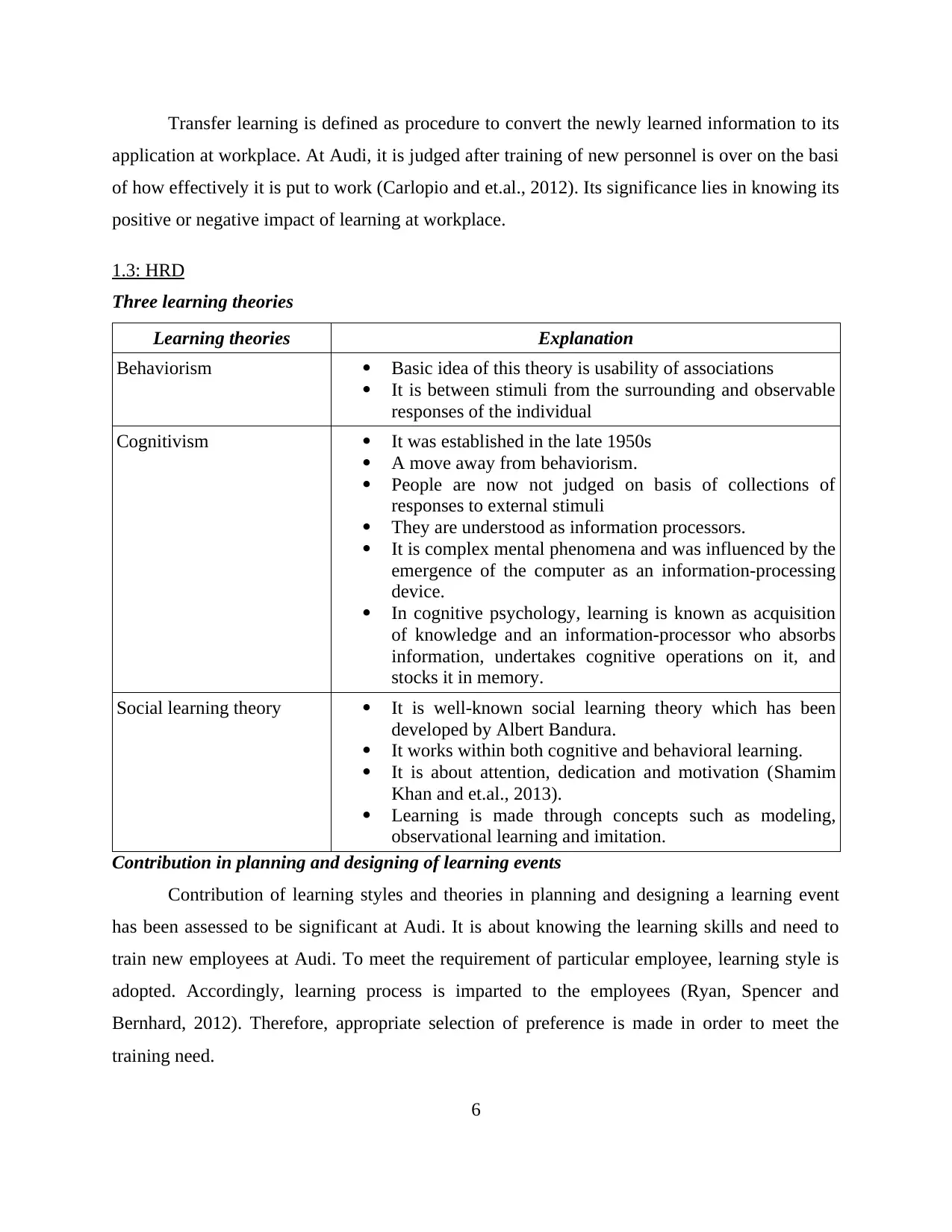
Transfer learning is defined as procedure to convert the newly learned information to its
application at workplace. At Audi, it is judged after training of new personnel is over on the basi
of how effectively it is put to work (Carlopio and et.al., 2012). Its significance lies in knowing its
positive or negative impact of learning at workplace.
1.3: HRD
Three learning theories
Learning theories Explanation
Behaviorism Basic idea of this theory is usability of associations
It is between stimuli from the surrounding and observable
responses of the individual
Cognitivism It was established in the late 1950s
A move away from behaviorism.
People are now not judged on basis of collections of
responses to external stimuli
They are understood as information processors.
It is complex mental phenomena and was influenced by the
emergence of the computer as an information-processing
device.
In cognitive psychology, learning is known as acquisition
of knowledge and an information-processor who absorbs
information, undertakes cognitive operations on it, and
stocks it in memory.
Social learning theory It is well-known social learning theory which has been
developed by Albert Bandura.
It works within both cognitive and behavioral learning.
It is about attention, dedication and motivation (Shamim
Khan and et.al., 2013).
Learning is made through concepts such as modeling,
observational learning and imitation.
Contribution in planning and designing of learning events
Contribution of learning styles and theories in planning and designing a learning event
has been assessed to be significant at Audi. It is about knowing the learning skills and need to
train new employees at Audi. To meet the requirement of particular employee, learning style is
adopted. Accordingly, learning process is imparted to the employees (Ryan, Spencer and
Bernhard, 2012). Therefore, appropriate selection of preference is made in order to meet the
training need.
6
application at workplace. At Audi, it is judged after training of new personnel is over on the basi
of how effectively it is put to work (Carlopio and et.al., 2012). Its significance lies in knowing its
positive or negative impact of learning at workplace.
1.3: HRD
Three learning theories
Learning theories Explanation
Behaviorism Basic idea of this theory is usability of associations
It is between stimuli from the surrounding and observable
responses of the individual
Cognitivism It was established in the late 1950s
A move away from behaviorism.
People are now not judged on basis of collections of
responses to external stimuli
They are understood as information processors.
It is complex mental phenomena and was influenced by the
emergence of the computer as an information-processing
device.
In cognitive psychology, learning is known as acquisition
of knowledge and an information-processor who absorbs
information, undertakes cognitive operations on it, and
stocks it in memory.
Social learning theory It is well-known social learning theory which has been
developed by Albert Bandura.
It works within both cognitive and behavioral learning.
It is about attention, dedication and motivation (Shamim
Khan and et.al., 2013).
Learning is made through concepts such as modeling,
observational learning and imitation.
Contribution in planning and designing of learning events
Contribution of learning styles and theories in planning and designing a learning event
has been assessed to be significant at Audi. It is about knowing the learning skills and need to
train new employees at Audi. To meet the requirement of particular employee, learning style is
adopted. Accordingly, learning process is imparted to the employees (Ryan, Spencer and
Bernhard, 2012). Therefore, appropriate selection of preference is made in order to meet the
training need.
6
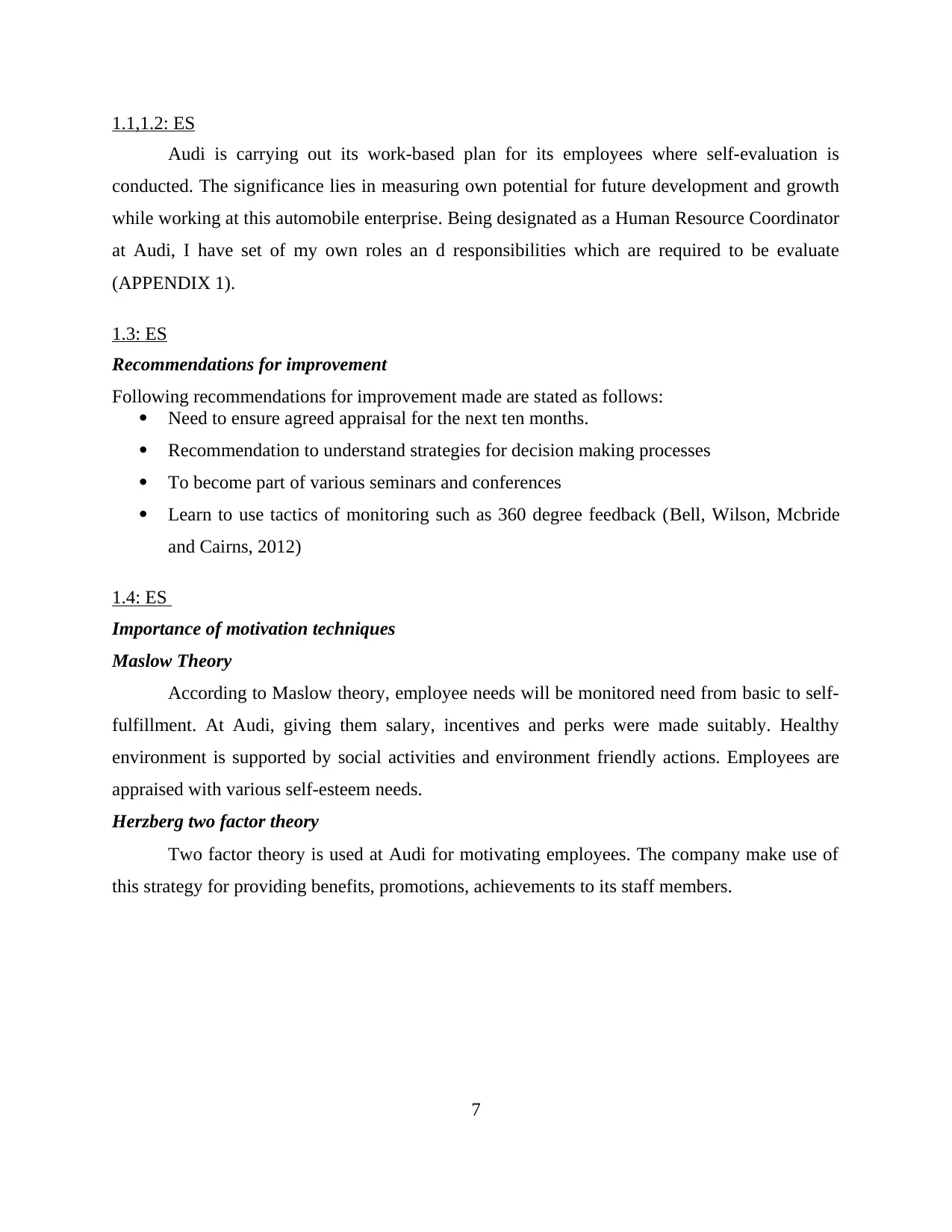
1.1,1.2: ES
Audi is carrying out its work-based plan for its employees where self-evaluation is
conducted. The significance lies in measuring own potential for future development and growth
while working at this automobile enterprise. Being designated as a Human Resource Coordinator
at Audi, I have set of my own roles an d responsibilities which are required to be evaluate
(APPENDIX 1).
1.3: ES
Recommendations for improvement
Following recommendations for improvement made are stated as follows:
Need to ensure agreed appraisal for the next ten months.
Recommendation to understand strategies for decision making processes
To become part of various seminars and conferences
Learn to use tactics of monitoring such as 360 degree feedback (Bell, Wilson, Mcbride
and Cairns, 2012)
1.4: ES
Importance of motivation techniques
Maslow Theory
According to Maslow theory, employee needs will be monitored need from basic to self-
fulfillment. At Audi, giving them salary, incentives and perks were made suitably. Healthy
environment is supported by social activities and environment friendly actions. Employees are
appraised with various self-esteem needs.
Herzberg two factor theory
Two factor theory is used at Audi for motivating employees. The company make use of
this strategy for providing benefits, promotions, achievements to its staff members.
7
Audi is carrying out its work-based plan for its employees where self-evaluation is
conducted. The significance lies in measuring own potential for future development and growth
while working at this automobile enterprise. Being designated as a Human Resource Coordinator
at Audi, I have set of my own roles an d responsibilities which are required to be evaluate
(APPENDIX 1).
1.3: ES
Recommendations for improvement
Following recommendations for improvement made are stated as follows:
Need to ensure agreed appraisal for the next ten months.
Recommendation to understand strategies for decision making processes
To become part of various seminars and conferences
Learn to use tactics of monitoring such as 360 degree feedback (Bell, Wilson, Mcbride
and Cairns, 2012)
1.4: ES
Importance of motivation techniques
Maslow Theory
According to Maslow theory, employee needs will be monitored need from basic to self-
fulfillment. At Audi, giving them salary, incentives and perks were made suitably. Healthy
environment is supported by social activities and environment friendly actions. Employees are
appraised with various self-esteem needs.
Herzberg two factor theory
Two factor theory is used at Audi for motivating employees. The company make use of
this strategy for providing benefits, promotions, achievements to its staff members.
7
Secure Best Marks with AI Grader
Need help grading? Try our AI Grader for instant feedback on your assignments.
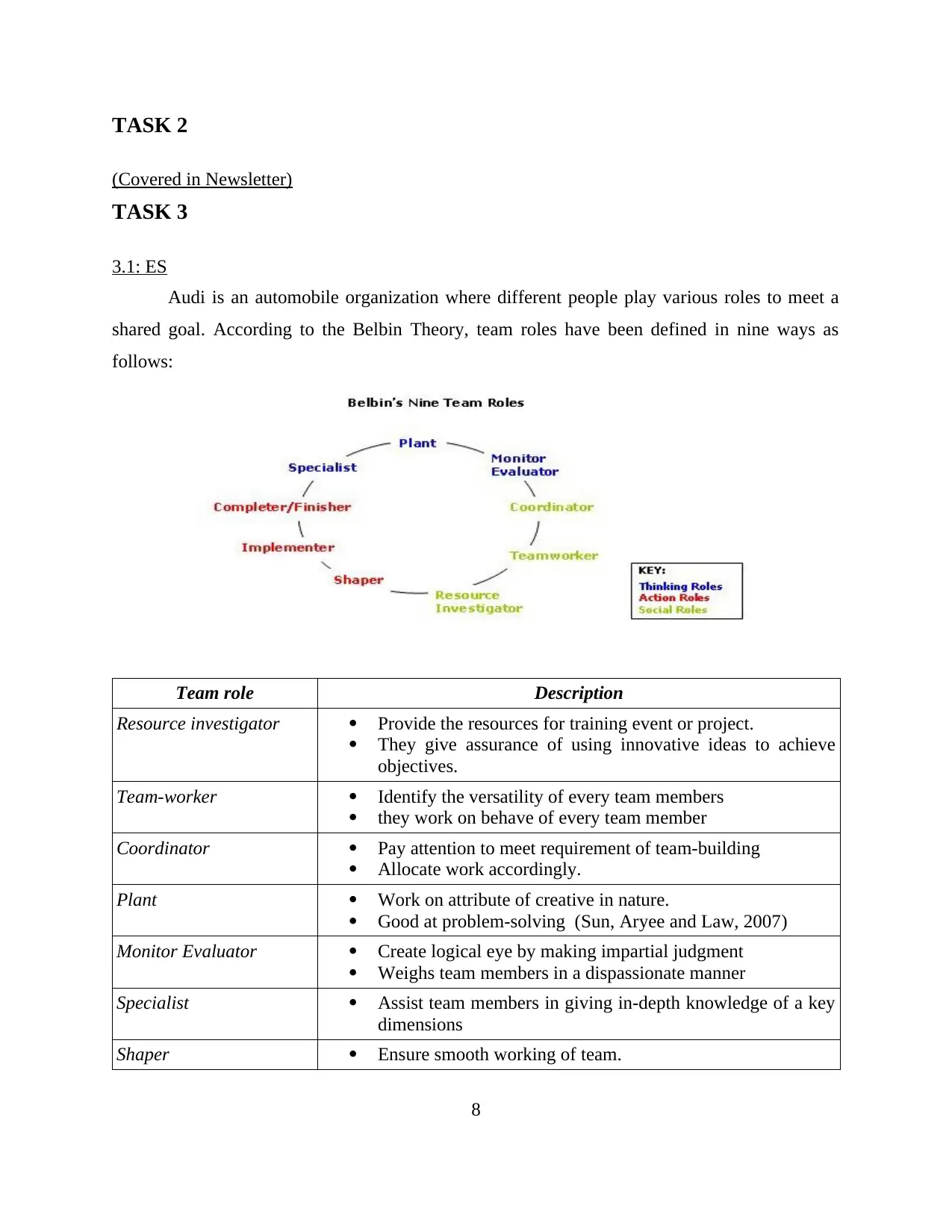
TASK 2
(Covered in Newsletter)
TASK 3
3.1: ES
Audi is an automobile organization where different people play various roles to meet a
shared goal. According to the Belbin Theory, team roles have been defined in nine ways as
follows:
Team role Description
Resource investigator Provide the resources for training event or project.
They give assurance of using innovative ideas to achieve
objectives.
Team-worker Identify the versatility of every team members
they work on behave of every team member
Coordinator Pay attention to meet requirement of team-building
Allocate work accordingly.
Plant Work on attribute of creative in nature.
Good at problem-solving (Sun, Aryee and Law, 2007)
Monitor Evaluator Create logical eye by making impartial judgment
Weighs team members in a dispassionate manner
Specialist Assist team members in giving in-depth knowledge of a key
dimensions
Shaper Ensure smooth working of team.
8
(Covered in Newsletter)
TASK 3
3.1: ES
Audi is an automobile organization where different people play various roles to meet a
shared goal. According to the Belbin Theory, team roles have been defined in nine ways as
follows:
Team role Description
Resource investigator Provide the resources for training event or project.
They give assurance of using innovative ideas to achieve
objectives.
Team-worker Identify the versatility of every team members
they work on behave of every team member
Coordinator Pay attention to meet requirement of team-building
Allocate work accordingly.
Plant Work on attribute of creative in nature.
Good at problem-solving (Sun, Aryee and Law, 2007)
Monitor Evaluator Create logical eye by making impartial judgment
Weighs team members in a dispassionate manner
Specialist Assist team members in giving in-depth knowledge of a key
dimensions
Shaper Ensure smooth working of team.
8
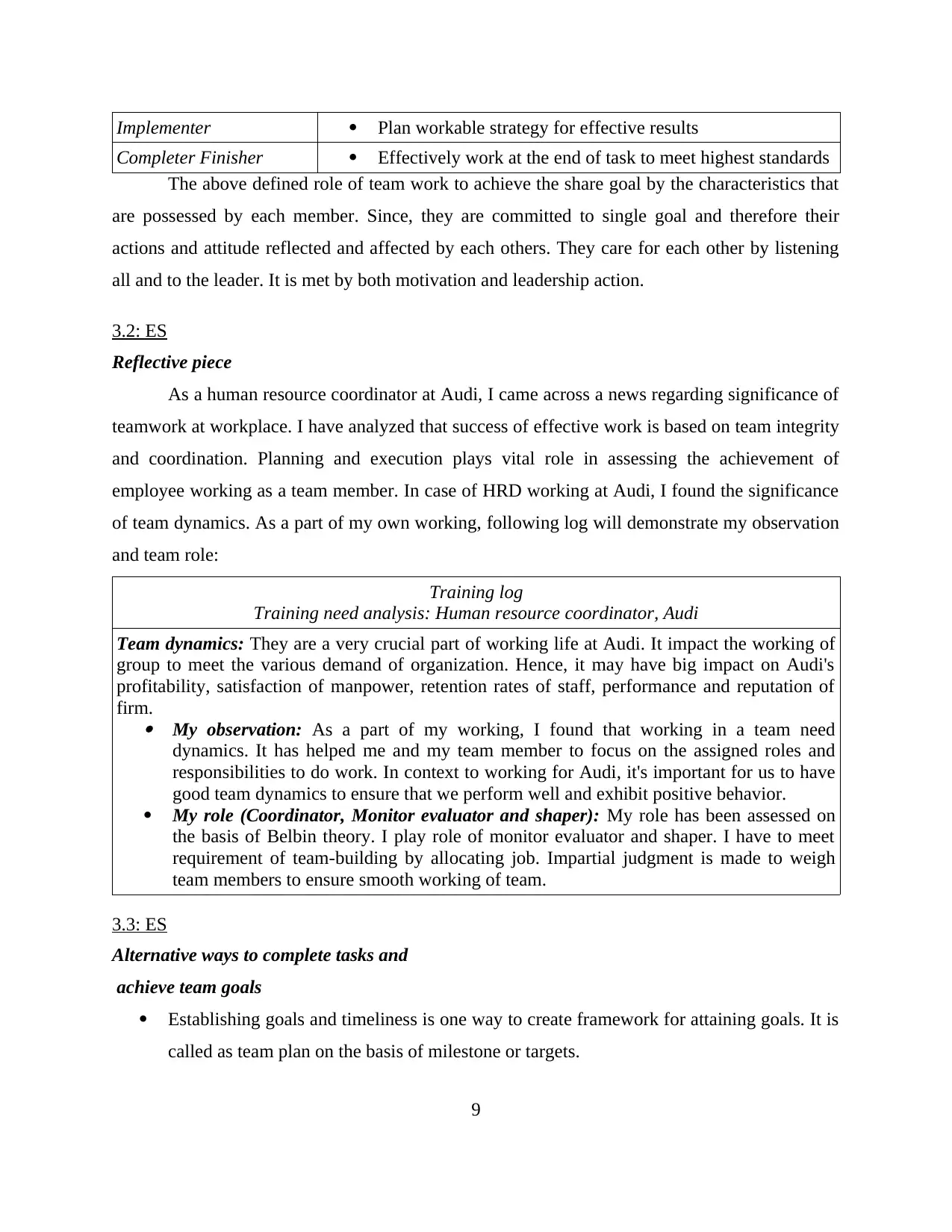
Implementer Plan workable strategy for effective results
Completer Finisher Effectively work at the end of task to meet highest standards
The above defined role of team work to achieve the share goal by the characteristics that
are possessed by each member. Since, they are committed to single goal and therefore their
actions and attitude reflected and affected by each others. They care for each other by listening
all and to the leader. It is met by both motivation and leadership action.
3.2: ES
Reflective piece
As a human resource coordinator at Audi, I came across a news regarding significance of
teamwork at workplace. I have analyzed that success of effective work is based on team integrity
and coordination. Planning and execution plays vital role in assessing the achievement of
employee working as a team member. In case of HRD working at Audi, I found the significance
of team dynamics. As a part of my own working, following log will demonstrate my observation
and team role:
Training log
Training need analysis: Human resource coordinator, Audi
Team dynamics: They are a very crucial part of working life at Audi. It impact the working of
group to meet the various demand of organization. Hence, it may have big impact on Audi's
profitability, satisfaction of manpower, retention rates of staff, performance and reputation of
firm.
My observation: As a part of my working, I found that working in a team need
dynamics. It has helped me and my team member to focus on the assigned roles and
responsibilities to do work. In context to working for Audi, it's important for us to have
good team dynamics to ensure that we perform well and exhibit positive behavior.
My role (Coordinator, Monitor evaluator and shaper): My role has been assessed on
the basis of Belbin theory. I play role of monitor evaluator and shaper. I have to meet
requirement of team-building by allocating job. Impartial judgment is made to weigh
team members to ensure smooth working of team.
3.3: ES
Alternative ways to complete tasks and
achieve team goals
Establishing goals and timeliness is one way to create framework for attaining goals. It is
called as team plan on the basis of milestone or targets.
9
Completer Finisher Effectively work at the end of task to meet highest standards
The above defined role of team work to achieve the share goal by the characteristics that
are possessed by each member. Since, they are committed to single goal and therefore their
actions and attitude reflected and affected by each others. They care for each other by listening
all and to the leader. It is met by both motivation and leadership action.
3.2: ES
Reflective piece
As a human resource coordinator at Audi, I came across a news regarding significance of
teamwork at workplace. I have analyzed that success of effective work is based on team integrity
and coordination. Planning and execution plays vital role in assessing the achievement of
employee working as a team member. In case of HRD working at Audi, I found the significance
of team dynamics. As a part of my own working, following log will demonstrate my observation
and team role:
Training log
Training need analysis: Human resource coordinator, Audi
Team dynamics: They are a very crucial part of working life at Audi. It impact the working of
group to meet the various demand of organization. Hence, it may have big impact on Audi's
profitability, satisfaction of manpower, retention rates of staff, performance and reputation of
firm.
My observation: As a part of my working, I found that working in a team need
dynamics. It has helped me and my team member to focus on the assigned roles and
responsibilities to do work. In context to working for Audi, it's important for us to have
good team dynamics to ensure that we perform well and exhibit positive behavior.
My role (Coordinator, Monitor evaluator and shaper): My role has been assessed on
the basis of Belbin theory. I play role of monitor evaluator and shaper. I have to meet
requirement of team-building by allocating job. Impartial judgment is made to weigh
team members to ensure smooth working of team.
3.3: ES
Alternative ways to complete tasks and
achieve team goals
Establishing goals and timeliness is one way to create framework for attaining goals. It is
called as team plan on the basis of milestone or targets.
9
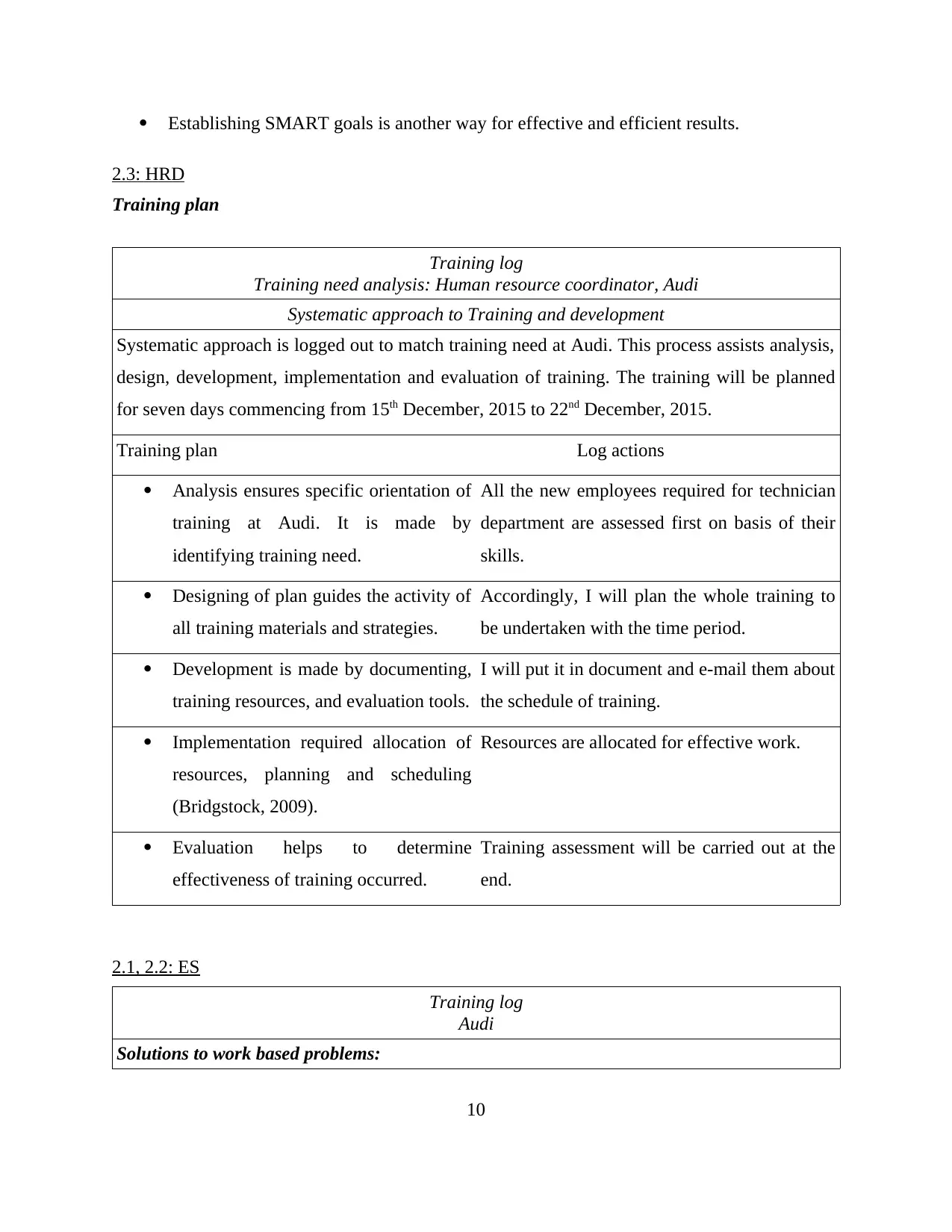
Establishing SMART goals is another way for effective and efficient results.
2.3: HRD
Training plan
Training log
Training need analysis: Human resource coordinator, Audi
Systematic approach to Training and development
Systematic approach is logged out to match training need at Audi. This process assists analysis,
design, development, implementation and evaluation of training. The training will be planned
for seven days commencing from 15th December, 2015 to 22nd December, 2015.
Training plan Log actions
Analysis ensures specific orientation of
training at Audi. It is made by
identifying training need.
All the new employees required for technician
department are assessed first on basis of their
skills.
Designing of plan guides the activity of
all training materials and strategies.
Accordingly, I will plan the whole training to
be undertaken with the time period.
Development is made by documenting,
training resources, and evaluation tools.
I will put it in document and e-mail them about
the schedule of training.
Implementation required allocation of
resources, planning and scheduling
(Bridgstock, 2009).
Resources are allocated for effective work.
Evaluation helps to determine
effectiveness of training occurred.
Training assessment will be carried out at the
end.
2.1, 2.2: ES
Training log
Audi
Solutions to work based problems:
10
2.3: HRD
Training plan
Training log
Training need analysis: Human resource coordinator, Audi
Systematic approach to Training and development
Systematic approach is logged out to match training need at Audi. This process assists analysis,
design, development, implementation and evaluation of training. The training will be planned
for seven days commencing from 15th December, 2015 to 22nd December, 2015.
Training plan Log actions
Analysis ensures specific orientation of
training at Audi. It is made by
identifying training need.
All the new employees required for technician
department are assessed first on basis of their
skills.
Designing of plan guides the activity of
all training materials and strategies.
Accordingly, I will plan the whole training to
be undertaken with the time period.
Development is made by documenting,
training resources, and evaluation tools.
I will put it in document and e-mail them about
the schedule of training.
Implementation required allocation of
resources, planning and scheduling
(Bridgstock, 2009).
Resources are allocated for effective work.
Evaluation helps to determine
effectiveness of training occurred.
Training assessment will be carried out at the
end.
2.1, 2.2: ES
Training log
Audi
Solutions to work based problems:
10
Paraphrase This Document
Need a fresh take? Get an instant paraphrase of this document with our AI Paraphraser
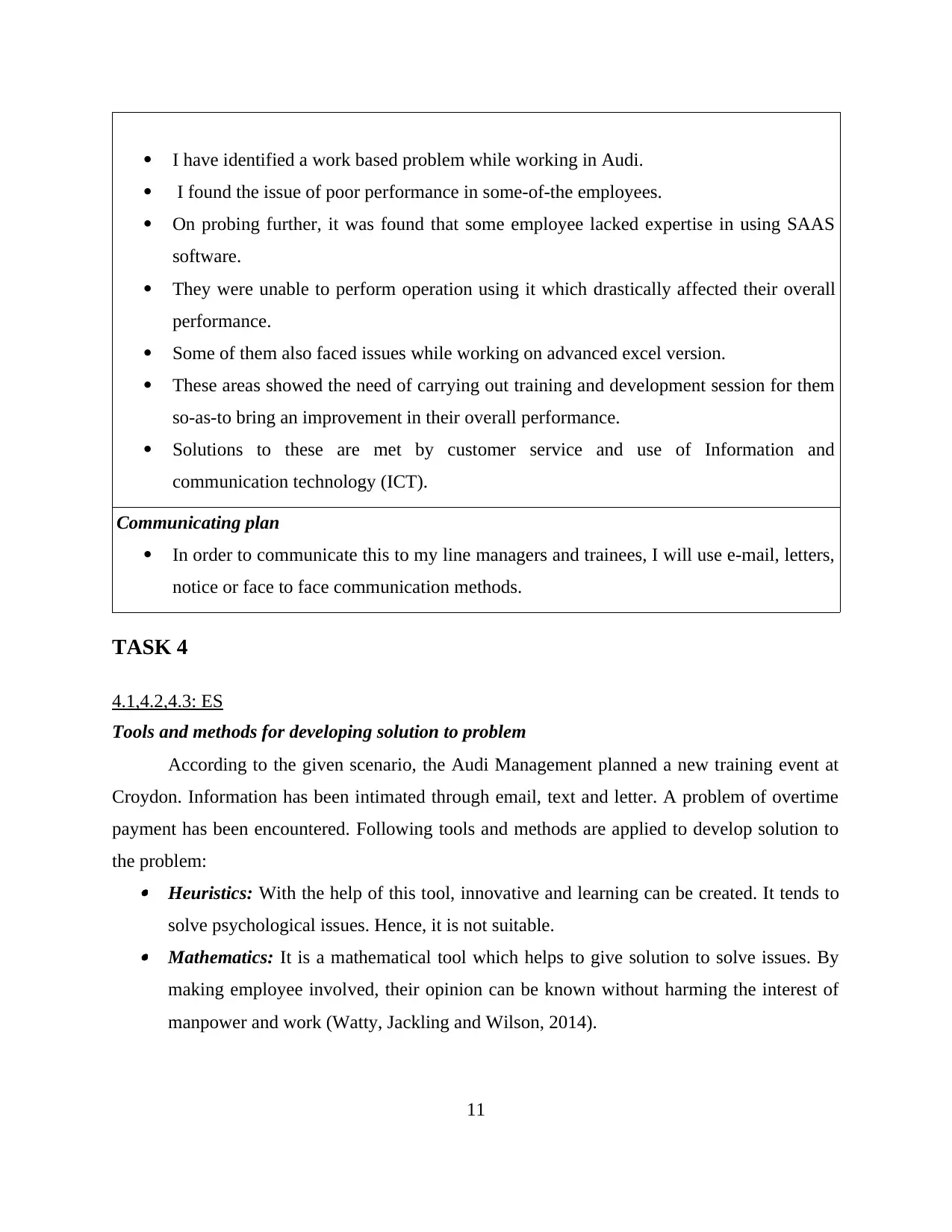
I have identified a work based problem while working in Audi.
I found the issue of poor performance in some-of-the employees.
On probing further, it was found that some employee lacked expertise in using SAAS
software.
They were unable to perform operation using it which drastically affected their overall
performance.
Some of them also faced issues while working on advanced excel version.
These areas showed the need of carrying out training and development session for them
so-as-to bring an improvement in their overall performance.
Solutions to these are met by customer service and use of Information and
communication technology (ICT).
Communicating plan
In order to communicate this to my line managers and trainees, I will use e-mail, letters,
notice or face to face communication methods.
TASK 4
4.1,4.2,4.3: ES
Tools and methods for developing solution to problem
According to the given scenario, the Audi Management planned a new training event at
Croydon. Information has been intimated through email, text and letter. A problem of overtime
payment has been encountered. Following tools and methods are applied to develop solution to
the problem: Heuristics: With the help of this tool, innovative and learning can be created. It tends to
solve psychological issues. Hence, it is not suitable. Mathematics: It is a mathematical tool which helps to give solution to solve issues. By
making employee involved, their opinion can be known without harming the interest of
manpower and work (Watty, Jackling and Wilson, 2014).
11
I found the issue of poor performance in some-of-the employees.
On probing further, it was found that some employee lacked expertise in using SAAS
software.
They were unable to perform operation using it which drastically affected their overall
performance.
Some of them also faced issues while working on advanced excel version.
These areas showed the need of carrying out training and development session for them
so-as-to bring an improvement in their overall performance.
Solutions to these are met by customer service and use of Information and
communication technology (ICT).
Communicating plan
In order to communicate this to my line managers and trainees, I will use e-mail, letters,
notice or face to face communication methods.
TASK 4
4.1,4.2,4.3: ES
Tools and methods for developing solution to problem
According to the given scenario, the Audi Management planned a new training event at
Croydon. Information has been intimated through email, text and letter. A problem of overtime
payment has been encountered. Following tools and methods are applied to develop solution to
the problem: Heuristics: With the help of this tool, innovative and learning can be created. It tends to
solve psychological issues. Hence, it is not suitable. Mathematics: It is a mathematical tool which helps to give solution to solve issues. By
making employee involved, their opinion can be known without harming the interest of
manpower and work (Watty, Jackling and Wilson, 2014).
11
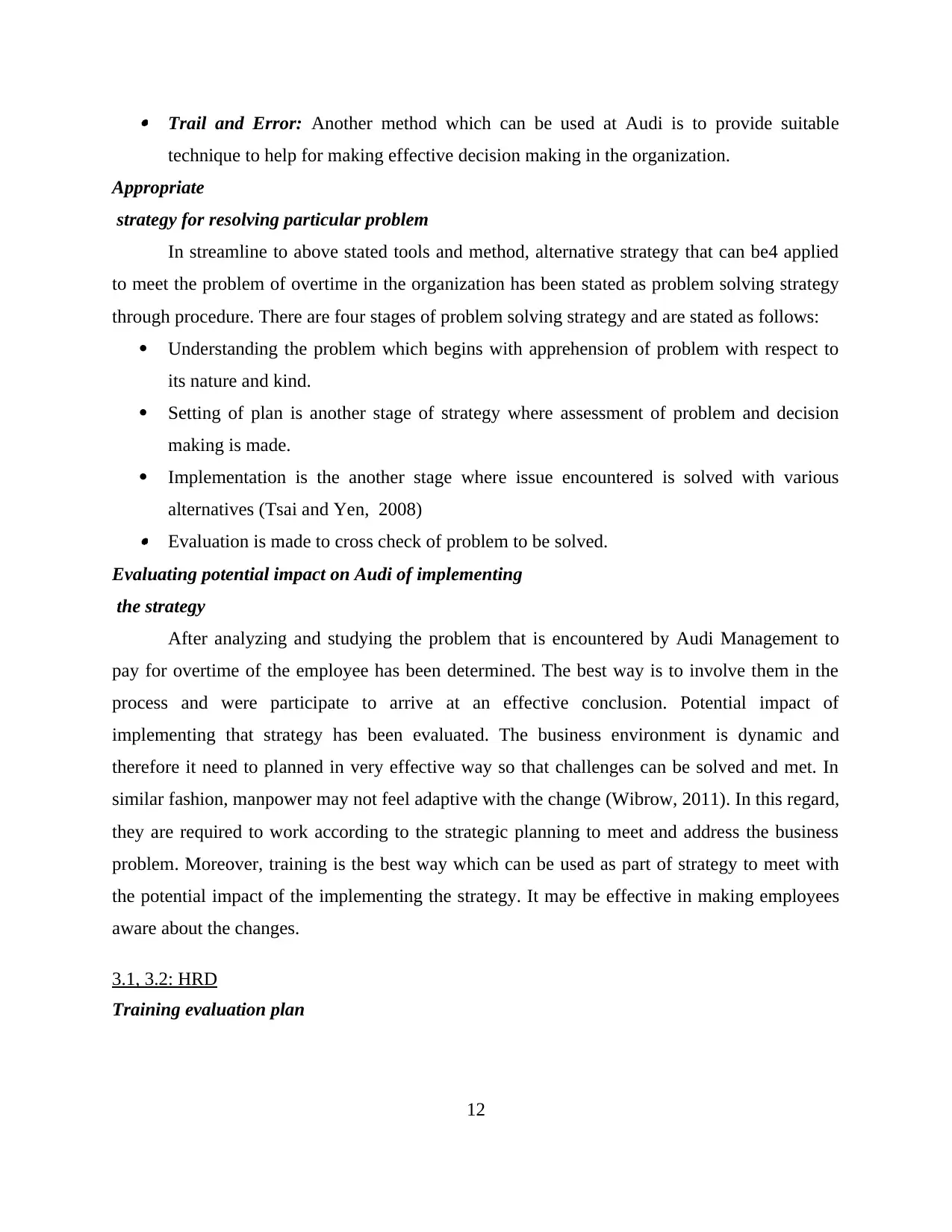
Trail and Error: Another method which can be used at Audi is to provide suitable
technique to help for making effective decision making in the organization.
Appropriate
strategy for resolving particular problem
In streamline to above stated tools and method, alternative strategy that can be4 applied
to meet the problem of overtime in the organization has been stated as problem solving strategy
through procedure. There are four stages of problem solving strategy and are stated as follows:
Understanding the problem which begins with apprehension of problem with respect to
its nature and kind.
Setting of plan is another stage of strategy where assessment of problem and decision
making is made.
Implementation is the another stage where issue encountered is solved with various
alternatives (Tsai and Yen, 2008) Evaluation is made to cross check of problem to be solved.
Evaluating potential impact on Audi of implementing
the strategy
After analyzing and studying the problem that is encountered by Audi Management to
pay for overtime of the employee has been determined. The best way is to involve them in the
process and were participate to arrive at an effective conclusion. Potential impact of
implementing that strategy has been evaluated. The business environment is dynamic and
therefore it need to planned in very effective way so that challenges can be solved and met. In
similar fashion, manpower may not feel adaptive with the change (Wibrow, 2011). In this regard,
they are required to work according to the strategic planning to meet and address the business
problem. Moreover, training is the best way which can be used as part of strategy to meet with
the potential impact of the implementing the strategy. It may be effective in making employees
aware about the changes.
3.1, 3.2: HRD
Training evaluation plan
12
technique to help for making effective decision making in the organization.
Appropriate
strategy for resolving particular problem
In streamline to above stated tools and method, alternative strategy that can be4 applied
to meet the problem of overtime in the organization has been stated as problem solving strategy
through procedure. There are four stages of problem solving strategy and are stated as follows:
Understanding the problem which begins with apprehension of problem with respect to
its nature and kind.
Setting of plan is another stage of strategy where assessment of problem and decision
making is made.
Implementation is the another stage where issue encountered is solved with various
alternatives (Tsai and Yen, 2008) Evaluation is made to cross check of problem to be solved.
Evaluating potential impact on Audi of implementing
the strategy
After analyzing and studying the problem that is encountered by Audi Management to
pay for overtime of the employee has been determined. The best way is to involve them in the
process and were participate to arrive at an effective conclusion. Potential impact of
implementing that strategy has been evaluated. The business environment is dynamic and
therefore it need to planned in very effective way so that challenges can be solved and met. In
similar fashion, manpower may not feel adaptive with the change (Wibrow, 2011). In this regard,
they are required to work according to the strategic planning to meet and address the business
problem. Moreover, training is the best way which can be used as part of strategy to meet with
the potential impact of the implementing the strategy. It may be effective in making employees
aware about the changes.
3.1, 3.2: HRD
Training evaluation plan
12
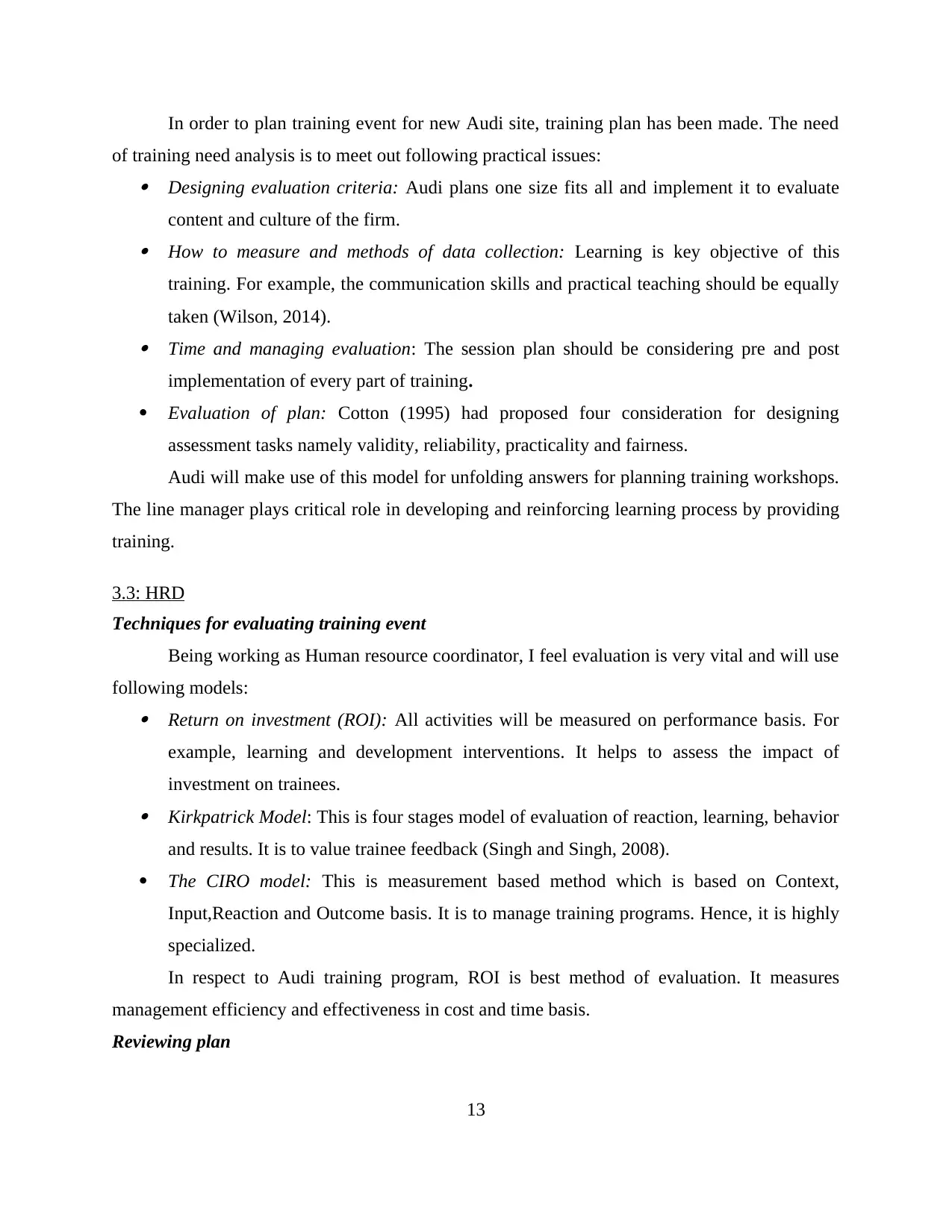
In order to plan training event for new Audi site, training plan has been made. The need
of training need analysis is to meet out following practical issues: Designing evaluation criteria: Audi plans one size fits all and implement it to evaluate
content and culture of the firm. How to measure and methods of data collection: Learning is key objective of this
training. For example, the communication skills and practical teaching should be equally
taken (Wilson, 2014). Time and managing evaluation: The session plan should be considering pre and post
implementation of every part of training.
Evaluation of plan: Cotton (1995) had proposed four consideration for designing
assessment tasks namely validity, reliability, practicality and fairness.
Audi will make use of this model for unfolding answers for planning training workshops.
The line manager plays critical role in developing and reinforcing learning process by providing
training.
3.3: HRD
Techniques for evaluating training event
Being working as Human resource coordinator, I feel evaluation is very vital and will use
following models: Return on investment (ROI): All activities will be measured on performance basis. For
example, learning and development interventions. It helps to assess the impact of
investment on trainees. Kirkpatrick Model: This is four stages model of evaluation of reaction, learning, behavior
and results. It is to value trainee feedback (Singh and Singh, 2008).
The CIRO model: This is measurement based method which is based on Context,
Input,Reaction and Outcome basis. It is to manage training programs. Hence, it is highly
specialized.
In respect to Audi training program, ROI is best method of evaluation. It measures
management efficiency and effectiveness in cost and time basis.
Reviewing plan
13
of training need analysis is to meet out following practical issues: Designing evaluation criteria: Audi plans one size fits all and implement it to evaluate
content and culture of the firm. How to measure and methods of data collection: Learning is key objective of this
training. For example, the communication skills and practical teaching should be equally
taken (Wilson, 2014). Time and managing evaluation: The session plan should be considering pre and post
implementation of every part of training.
Evaluation of plan: Cotton (1995) had proposed four consideration for designing
assessment tasks namely validity, reliability, practicality and fairness.
Audi will make use of this model for unfolding answers for planning training workshops.
The line manager plays critical role in developing and reinforcing learning process by providing
training.
3.3: HRD
Techniques for evaluating training event
Being working as Human resource coordinator, I feel evaluation is very vital and will use
following models: Return on investment (ROI): All activities will be measured on performance basis. For
example, learning and development interventions. It helps to assess the impact of
investment on trainees. Kirkpatrick Model: This is four stages model of evaluation of reaction, learning, behavior
and results. It is to value trainee feedback (Singh and Singh, 2008).
The CIRO model: This is measurement based method which is based on Context,
Input,Reaction and Outcome basis. It is to manage training programs. Hence, it is highly
specialized.
In respect to Audi training program, ROI is best method of evaluation. It measures
management efficiency and effectiveness in cost and time basis.
Reviewing plan
13
Secure Best Marks with AI Grader
Need help grading? Try our AI Grader for instant feedback on your assignments.

The objective of training plan is set with objectives need of the firm and so goals should
be flexible.
The effectiveness is reflected from point of view of training program which should be
suitably applied (Shafie and Nayan, 2010).
Reviewing is crucially designed for the benefit public and private sector organizations.
Handouts
(Covered in PPT)
CONCLUSION
With the help of this report, significance of training and development has been assessed.
It has been concluded that employability skills are key essential aspect of every organization. By
assessing my working experience at Audi as a human resource coordinator, various aspects of
HR department and manpower management have been analyzed.
14
be flexible.
The effectiveness is reflected from point of view of training program which should be
suitably applied (Shafie and Nayan, 2010).
Reviewing is crucially designed for the benefit public and private sector organizations.
Handouts
(Covered in PPT)
CONCLUSION
With the help of this report, significance of training and development has been assessed.
It has been concluded that employability skills are key essential aspect of every organization. By
assessing my working experience at Audi as a human resource coordinator, various aspects of
HR department and manpower management have been analyzed.
14
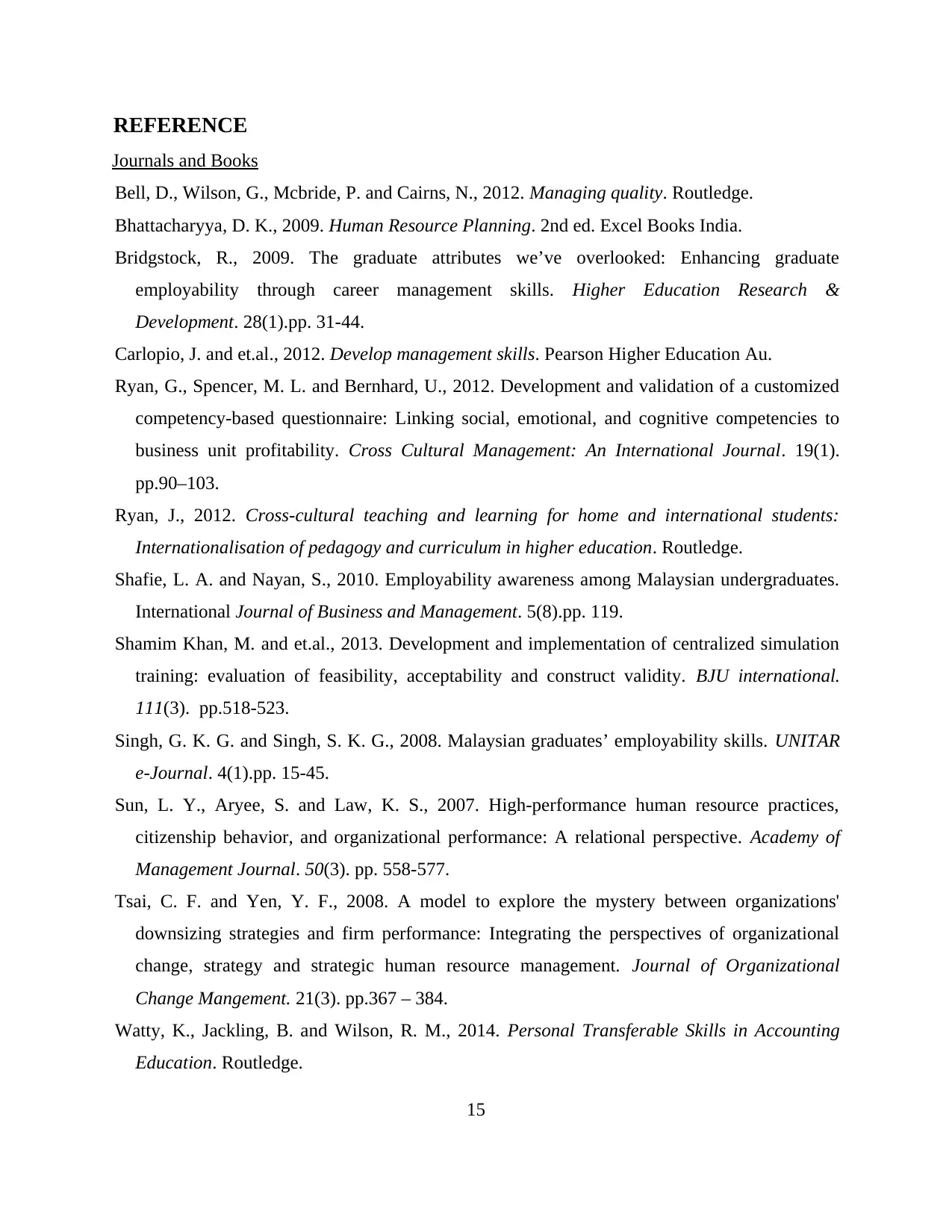
REFERENCE
Journals and Books
Bell, D., Wilson, G., Mcbride, P. and Cairns, N., 2012. Managing quality. Routledge.
Bhattacharyya, D. K., 2009. Human Resource Planning. 2nd ed. Excel Books India.
Bridgstock, R., 2009. The graduate attributes we’ve overlooked: Enhancing graduate
employability through career management skills. Higher Education Research &
Development. 28(1).pp. 31-44.
Carlopio, J. and et.al., 2012. Develop management skills. Pearson Higher Education Au.
Ryan, G., Spencer, M. L. and Bernhard, U., 2012. Development and validation of a customized
competency‐based questionnaire: Linking social, emotional, and cognitive competencies to
business unit profitability. Cross Cultural Management: An International Journal. 19(1).
pp.90–103.
Ryan, J., 2012. Cross-cultural teaching and learning for home and international students:
Internationalisation of pedagogy and curriculum in higher education. Routledge.
Shafie, L. A. and Nayan, S., 2010. Employability awareness among Malaysian undergraduates.
International Journal of Business and Management. 5(8).pp. 119.
Shamim Khan, M. and et.al., 2013. Development and implementation of centralized simulation
training: evaluation of feasibility, acceptability and construct validity. BJU international.
111(3). pp.518-523.
Singh, G. K. G. and Singh, S. K. G., 2008. Malaysian graduates’ employability skills. UNITAR
e-Journal. 4(1).pp. 15-45.
Sun, L. Y., Aryee, S. and Law, K. S., 2007. High-performance human resource practices,
citizenship behavior, and organizational performance: A relational perspective. Academy of
Management Journal. 50(3). pp. 558-577.
Tsai, C. F. and Yen, Y. F., 2008. A model to explore the mystery between organizations'
downsizing strategies and firm performance: Integrating the perspectives of organizational
change, strategy and strategic human resource management. Journal of Organizational
Change Mangement. 21(3). pp.367 – 384.
Watty, K., Jackling, B. and Wilson, R. M., 2014. Personal Transferable Skills in Accounting
Education. Routledge.
15
Journals and Books
Bell, D., Wilson, G., Mcbride, P. and Cairns, N., 2012. Managing quality. Routledge.
Bhattacharyya, D. K., 2009. Human Resource Planning. 2nd ed. Excel Books India.
Bridgstock, R., 2009. The graduate attributes we’ve overlooked: Enhancing graduate
employability through career management skills. Higher Education Research &
Development. 28(1).pp. 31-44.
Carlopio, J. and et.al., 2012. Develop management skills. Pearson Higher Education Au.
Ryan, G., Spencer, M. L. and Bernhard, U., 2012. Development and validation of a customized
competency‐based questionnaire: Linking social, emotional, and cognitive competencies to
business unit profitability. Cross Cultural Management: An International Journal. 19(1).
pp.90–103.
Ryan, J., 2012. Cross-cultural teaching and learning for home and international students:
Internationalisation of pedagogy and curriculum in higher education. Routledge.
Shafie, L. A. and Nayan, S., 2010. Employability awareness among Malaysian undergraduates.
International Journal of Business and Management. 5(8).pp. 119.
Shamim Khan, M. and et.al., 2013. Development and implementation of centralized simulation
training: evaluation of feasibility, acceptability and construct validity. BJU international.
111(3). pp.518-523.
Singh, G. K. G. and Singh, S. K. G., 2008. Malaysian graduates’ employability skills. UNITAR
e-Journal. 4(1).pp. 15-45.
Sun, L. Y., Aryee, S. and Law, K. S., 2007. High-performance human resource practices,
citizenship behavior, and organizational performance: A relational perspective. Academy of
Management Journal. 50(3). pp. 558-577.
Tsai, C. F. and Yen, Y. F., 2008. A model to explore the mystery between organizations'
downsizing strategies and firm performance: Integrating the perspectives of organizational
change, strategy and strategic human resource management. Journal of Organizational
Change Mangement. 21(3). pp.367 – 384.
Watty, K., Jackling, B. and Wilson, R. M., 2014. Personal Transferable Skills in Accounting
Education. Routledge.
15
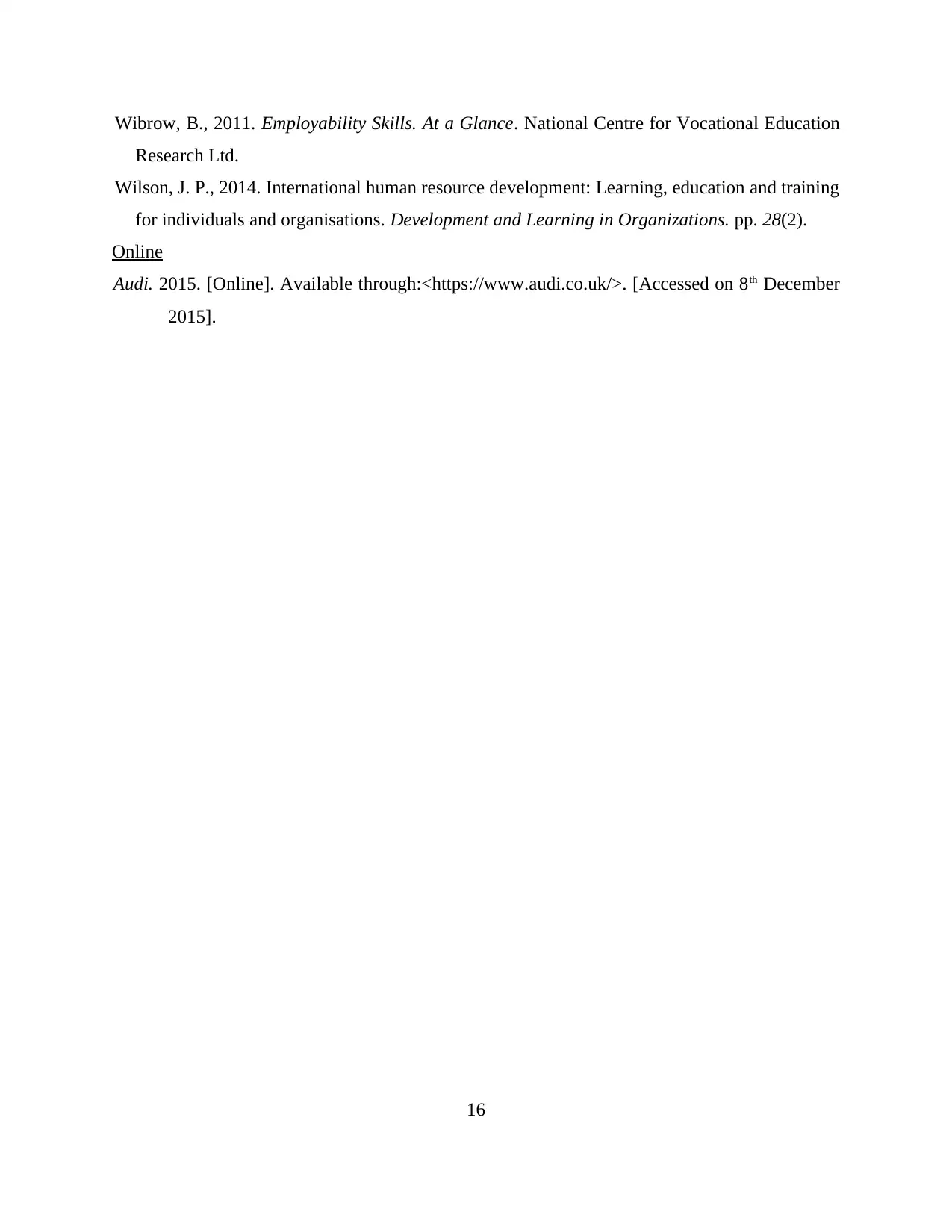
Wibrow, B., 2011. Employability Skills. At a Glance. National Centre for Vocational Education
Research Ltd.
Wilson, J. P., 2014. International human resource development: Learning, education and training
for individuals and organisations. Development and Learning in Organizations. pp. 28(2).
Online
Audi. 2015. [Online]. Available through:<https://www.audi.co.uk/>. [Accessed on 8th December
2015].
16
Research Ltd.
Wilson, J. P., 2014. International human resource development: Learning, education and training
for individuals and organisations. Development and Learning in Organizations. pp. 28(2).
Online
Audi. 2015. [Online]. Available through:<https://www.audi.co.uk/>. [Accessed on 8th December
2015].
16
Paraphrase This Document
Need a fresh take? Get an instant paraphrase of this document with our AI Paraphraser
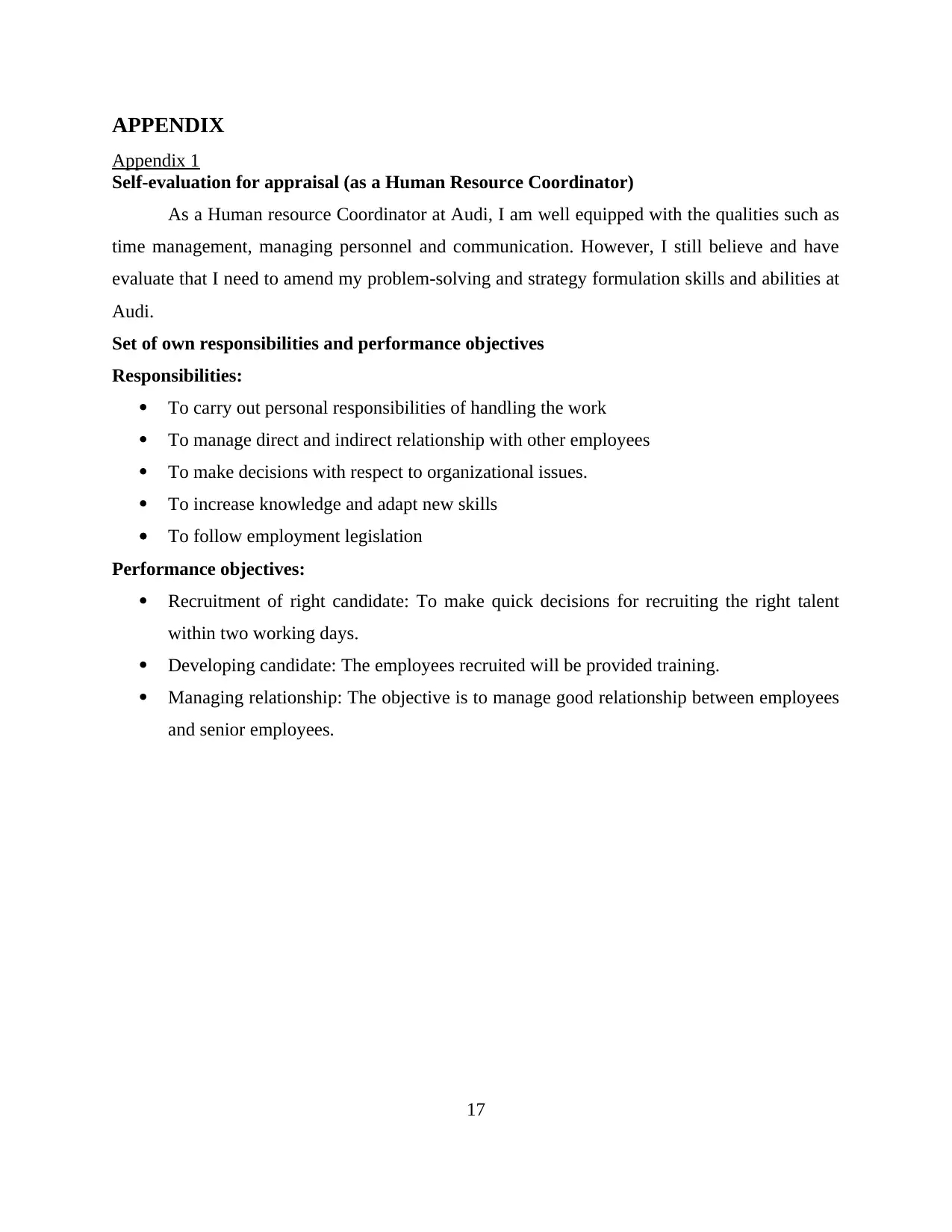
APPENDIX
Appendix 1
Self-evaluation for appraisal (as a Human Resource Coordinator)
As a Human resource Coordinator at Audi, I am well equipped with the qualities such as
time management, managing personnel and communication. However, I still believe and have
evaluate that I need to amend my problem-solving and strategy formulation skills and abilities at
Audi.
Set of own responsibilities and performance objectives
Responsibilities:
To carry out personal responsibilities of handling the work
To manage direct and indirect relationship with other employees
To make decisions with respect to organizational issues.
To increase knowledge and adapt new skills
To follow employment legislation
Performance objectives:
Recruitment of right candidate: To make quick decisions for recruiting the right talent
within two working days.
Developing candidate: The employees recruited will be provided training.
Managing relationship: The objective is to manage good relationship between employees
and senior employees.
17
Appendix 1
Self-evaluation for appraisal (as a Human Resource Coordinator)
As a Human resource Coordinator at Audi, I am well equipped with the qualities such as
time management, managing personnel and communication. However, I still believe and have
evaluate that I need to amend my problem-solving and strategy formulation skills and abilities at
Audi.
Set of own responsibilities and performance objectives
Responsibilities:
To carry out personal responsibilities of handling the work
To manage direct and indirect relationship with other employees
To make decisions with respect to organizational issues.
To increase knowledge and adapt new skills
To follow employment legislation
Performance objectives:
Recruitment of right candidate: To make quick decisions for recruiting the right talent
within two working days.
Developing candidate: The employees recruited will be provided training.
Managing relationship: The objective is to manage good relationship between employees
and senior employees.
17
1 out of 17
![[object Object]](/_next/static/media/star-bottom.7253800d.svg)





